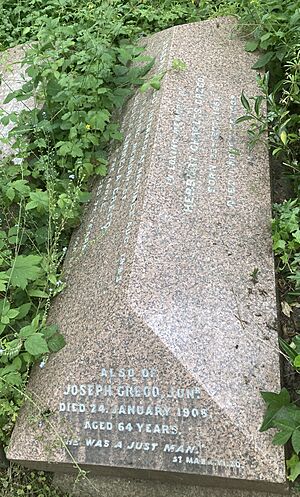Joseph Grego facts for kids
Joseph Grego (born September 23, 1843 – died January 24, 1908) was a very talented person. He was an art collector, someone who put on art shows, an author, a journalist, and even an inventor! He was also an expert in graphics and printing.
Contents
Early Life and Cool Inventions
Joseph Grego was born in London in 1843. His family had a history of making looking-glasses (mirrors). His grandfather, Antonio Grego, came from Como, Italy, and started the family business.
Joseph Grego himself was an inventor. He created something called the 'Colour Photo-Copier'. This amazing system could make copies of old 18th-century color prints that looked so real, people often thought they were the originals! He also helped run a photo-engraving company called Carl Hentschel Ltd. He even had a patent for making metal blocks used in printing. Joseph Grego was also a director for other big companies like Kegan Paul & Co. and The Graphic Company.
Writer and Editor of Art and Stories
After his schooling, Joseph Grego became an art journalist and author. He was especially good at writing about and collecting works by famous artists like James Gillray, Thomas Rowlandson, and George Morland. He also knew a lot about authors like Charles Dickens and artist George Cruikshank. People thought he was a true expert on all of them.
He helped create important books, like a collection of James Gillray's works in 1873 and 'Rowlandson the Caricaturist' in 1880. These books are still used as references today! He also published 'Cruickshank's Water Colours' in 1903, which showed beautiful color reproductions.
Grego also edited Pear's Pictorial magazine for many years. He wrote a book about the history of elections and edited other interesting books, including 'Pictorial Pickwickiana' about Charles Dickens and his illustrators.
Art Collector and Show Organizer
Joseph Grego loved collecting art, just like his father. As an art dealer, he often loaned his prints and drawings for public exhibitions. He spent a lot of his time organizing these shows, especially ones featuring 'English Humorists in Art'. He helped with exhibitions at the Royal Institute and Nottingham Castle. He even published a special souvenir booklet for the Royal Naval Exhibition in 1891.
From 1897 to 1899, Joseph Grego was the secretary of a special group called the 'Kernoozer's Club'.
Victorian Era Exhibition of 1897
Joseph Grego played a big part in the Victorian Era Exhibition 1897 in London. This huge event celebrated the Victorian age. He was on the committee that organized the "Historical and Commemorative Section," especially the part about Charles Dickens.
This section showed many interesting items related to Dickens, like old relics, autographs, paintings, and drawings that illustrated his famous novels. It also featured works by other great artists of the Victorian Era. Grego helped display a large collection of Dickens-related items, some of which were very rare and had never been seen by the public before.
Charles Dickens Memorial Display
In the "Art and Letters Room," there was a special "Charles Dickens Memorial" display. Here are some of the cool items that were shown:
- A silver cup given to Charles Dickens in 1858.
- Silver and tortoise-shell ashtrays given to Dickens by Benjamin Disraeli, a famous politician.
- The actual dispatch box Dickens used on his last reading tour to America.
- The writing desk of Thomas Hood, another famous humorist.
- A collection of handwritten letters from famous people like Charles Dickens, Thomas Carlyle, Tennyson, and Darwin.
- The last letter ever written by the Duke of Wellington.
- The writing table of Thomas Carlyle, a famous writer.
A special medal was made to remember the Victorian Era Exhibition of 1897. It had an image of Queen Victoria on the front and details about the exhibition on the back.
The Kernoozer's Club
Joseph Grego was the secretary of the Kernoozer's Club from 1897 to 1899. This was a small, special club for people who loved collecting and studying old arms and armor. Their motto meant "Our business is to seek out arms." They were known as the best "armor-club" in the world! The word "kernoozer" was a funny way of saying "connoisseur," which means an expert.
The club was started in 1881 by Charles Alexander, Baron de Cosson. It had only 20 members, and they met in each other's homes. Famous members included the explorer Sir Richard Burton and writer John Camden Hotten. The club was so well-known that similar groups started in Madrid and Paris. The Kernoozers Club eventually ended in 1922. A younger version of the club, the Junior Kernoozers Club, later became the Meyrick Society. Their amazing collections of armor are now a big part of the Wallace Collection in London.
Later Life and Legacy
Joseph Grego passed away on January 24, 1908, in the same house where he was born. He was buried in a family grave at Highgate Cemetery in London.
After he died, his huge collections of prints, drawings, and books were sold at famous auction houses like Christie's. The British Library still has many files related to Grego's work. Even though he worked with photography, not many of his own photos survived, except for some old glass negatives of Dickens's 'Pickwickiana'.
Joseph Grego was a truly remarkable person who contributed a lot to the world of art, literature, and history through his collecting, writing, and organizing skills.
Images for kids



